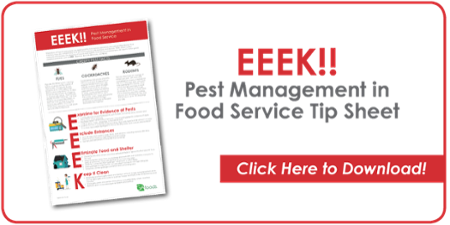 Roaches and other pests are, of course, a major concern for dining facilities – and the food industry as a whole. Aside from the basic “yuck factor”, which can certainly impact your customer base, these pests can be a serious health hazard to both workers and customers and can damage your bottom line via the destruction/contamination of products.
Roaches and other pests are, of course, a major concern for dining facilities – and the food industry as a whole. Aside from the basic “yuck factor”, which can certainly impact your customer base, these pests can be a serious health hazard to both workers and customers and can damage your bottom line via the destruction/contamination of products.
For these reasons, pest management is an integral part of day-to-day operations, and a good management plan depends heavily on knowing as much as possible about the issues you are working to prevent or resolve. To that end, here is everything you never wanted to know about roach and other common pest infestations.
About Roaches
Roaches – or cockroaches – are one of the most common pests to infest food service operations, and these pests have some very unpleasant characteristics. Among the most important of these is the fact that many have been shown to carry as many as 50 disease-causing microorganisms, according to the United Nations Industrial Development Organization (UNIDO), including those at the root of diseases like salmonella, cholera, typhoid and dysentery, among others.
As these pests invade stored foods or scuttle across surfaces, dishes and utensils, they can leave these pathogens behind, spreading these illnesses to your customers and workers. Roaches are also the source of allergens that can trigger allergic reactions in sensitive people and respiratory symptoms in asthma sufferers.
All roaches are nocturnal insects. Some types live primarily outdoors, making nighttime raids on food service facilities, while others move right in, hiding during the day and foraging at night. All reproduce at a rapid rate, with females producing up to 40 eggs per month.
Since roaches typically make themselves scarce when people are about, they can be difficult to detect – especially during the early stages of infestation. Signs to watch for include roach droppings – which typically look like bits of pepper – around likely hiding places. These may include cracks, crevices, under shelf liners, beneath or behind appliances, in storage areas, around garbage or in basements and/or drainage areas. Additionally, inspecting the facility after dark – walking into a dark, quiet area and switching the lights on – can reveal roach activity that might otherwise go undetected.
Rodent Invasions
Mice and rat infestations are another very common problem in dining facilities. These pests can present serious health hazards – carrying and spreading diseases that include salmonella hantavirus, tularemia, plague and typhus. They can be extremely destructive as well, invading and contaminating food supplies, and gnawing away at walls, electrical wires and much more as they make themselves at home in your facility.
Telltale signs of rodent infestations include a musty smell, brown droppings shaped like grains of rice and signs of gnawing on food packaging, trash bins and/or other items. Often, inspections done at night with a flashlight can catch these pests in action.
Flies
These flying insects – most commonly houseflies and/or fruit flies – are another pest that commonly plagues food service facilities. These creatures also have the potential to spread disease, often carrying a range of pathogens – as many as 100, according to Food Safety Magazine – that can cause diseases that include typhoid, cholera, salmonella, dysentery, and parasitic worms. These insects breed in areas that contain moist organic materials – food scraps, for example – such as garbage bins, drains or the floors in food preparation areas.
Efficient Facility Sanitation Procedures: Your First Line Of Defense Against Insect and Rodent Infestations
These pests invade dining facilities because they provide reliable sources of food and water. Integrated pest management can make these facilities less attractive to pests. Efficient sanitation procedures are an integral part of any good pest management plan – helping to prevent new infestations or resolve existing ones.
Sanitation measures that are key to preventing or resolving these issues include keeping foods in airtight containers and storing them at least 5 to 7 inches above the floor, keeping floors and surfaces free of food debris, thoroughly cleaning areas that collect organic waste – floors, floor drains and garbage bins, for instance – at least twice weekly, removing food cartons immediately after unpacking.
Leaving a clear space along walls – inside your facility and outdoors – can help discourage rodents, as can keeping clutter – handy for nesting – at a minimum throughout your facility. Inspecting for roach droppings regularly and removing any that are found is also important, since these are an important food source for newly hatched insects.
A good pest control specialist can advise you on other measures to take to discourage pests, such as sealing entry points, controlling moisture, baits, traps, poisons and effective inspection techniques. However, good sanitation is considered by many such experts as the single most effective means of pest control.
GA Foods' goal is to become the industry gold standard in food safety and facility sanitation. We also want to help other dining sites and facilities excel in food safety practices. For more information on pest management in food service, download our tip sheet:







